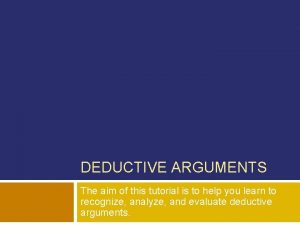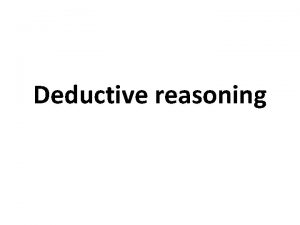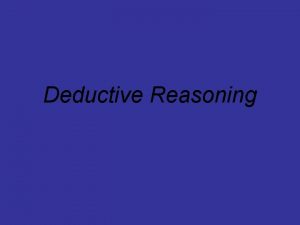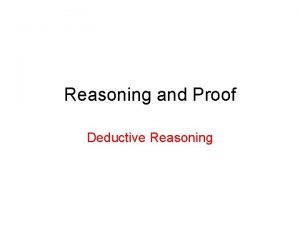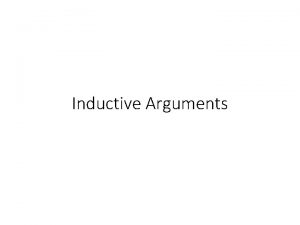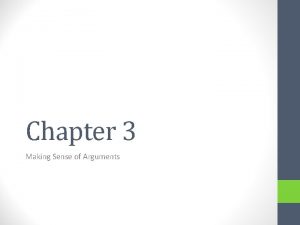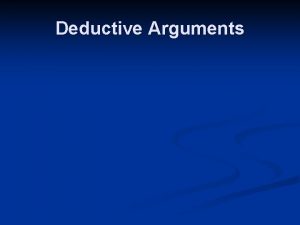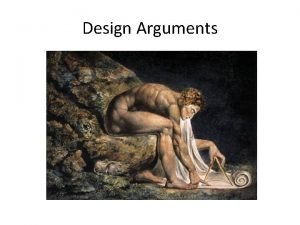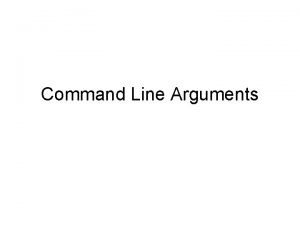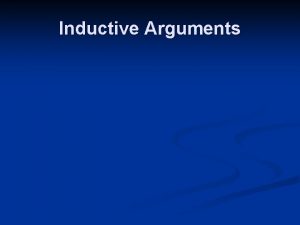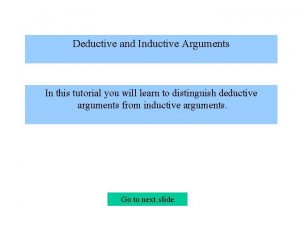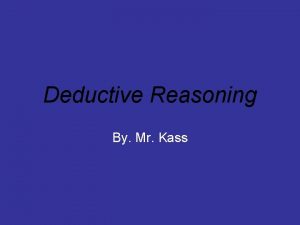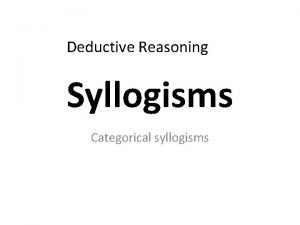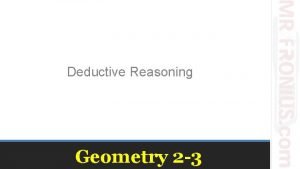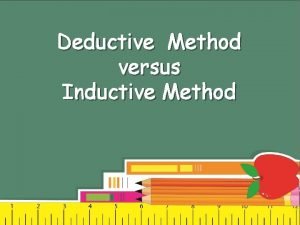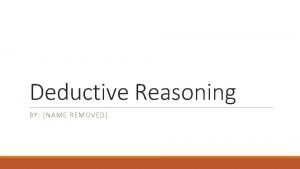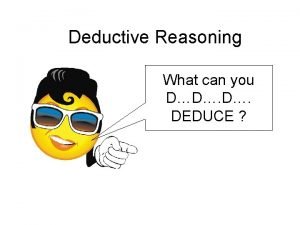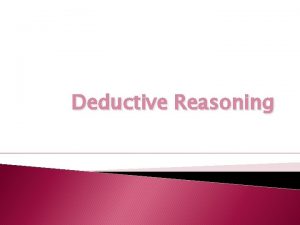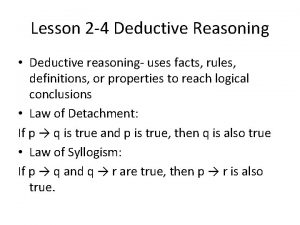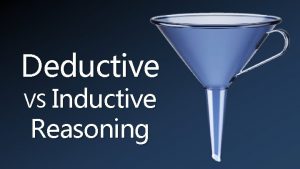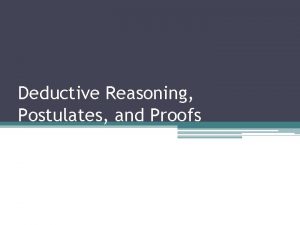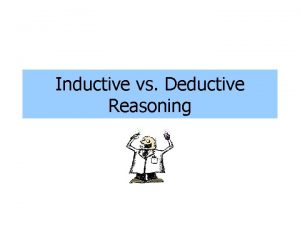DEDUCTIVE ARGUMENTS The aim of this tutorial is

























- Slides: 25

DEDUCTIVE ARGUMENTS The aim of this tutorial is to help you learn to recognize, analyze, and evaluate deductive arguments.

2 “When you have eliminated the impossible, whatever remains, however improbable, must be the truth. ” © 2012, The Mc. Graw-Hill Companies, Inc. All Rights Reserved.

Deductive arguments 3 A deductive argument claims that its conclusion necessarily follows from the premises. Certain words and phrases are commonly used in deductive arguments; these include certainly, absolutely, definitely, conclusively, must be, and it necessarily follows that. However, not all deductive arguments contain indicator words. © 2012, The Mc. Graw-Hill Companies, Inc. All Rights Reserved.

Hot or Not? 4 Are deductive arguments better than inductive arguments? © 2012, The Mc. Graw-Hill Companies, Inc. All Rights Reserved.

Deductive arguments and syllogisms 5 Deductive arguments are often presented in the form of syllogisms, with two supporting premises and a conclusion. A deductive argument is valid if the form of the argument is such that the conclusion must be true if the premises are true. The form of an argument is determined by its layout or pattern of reasoning. An argument is sound if both (1) it is valid, and (2) the premises are true. © 2012, The Mc. Graw-Hill Companies, Inc. All Rights Reserved.

6 No fish are dogs. All dogs are mammals. Therefore, some mammals are fish. © 2012, The Mc. Graw-Hill Companies, Inc. All Rights Reserved.

Types of deductive arguments 7 There are several types of deductive arguments. Three types are used in everyday reasoning: Arguments by elimination rule out different possibilities until only one possibility remains. Arguments based on mathematics depend on mathematical or geometric equations to generate conclusions. In an argument from definition, the conclusion is true because it is based on a key term or essential attribute in a definition. © 2012, The Mc. Graw-Hill Companies, Inc. All Rights Reserved.

8 A mouse locates the prize at the end of a maze through the deductive process of elimination. © 2012, The Mc. Graw-Hill Companies, Inc. All Rights Reserved.

9 Bo Dietl © 2012, The Mc. Graw-Hill Companies, Inc. All Rights Reserved.

10 The smooth landing of the Mars rovers was a result of the deductive reasoning skills of NASA scientists. © 2012, The Mc. Graw-Hill Companies, Inc. All Rights Reserved.

11 “Marilyn and Jessica cannot be married, since a marriage is a union between a man and a woman. ” This argument may no longer be sound because the legal definition of marriage is undergoing change. © 2012, The Mc. Graw-Hill Companies, Inc. All Rights Reserved.

Hypothetical syllogisms 12 Hypothetical reasoning involves “If…then…” reasoning. A hypothetical syllogism is a form of deductive argument that contains two premises, at least one of which is a hypothetical or conditional if…then statement. There are three basic patterns of hypothetical syllogisms: Modus ponens (affirming the antecedent) Modus tollens (denying the consequent) Chain arguments © 2012, The Mc. Graw-Hill Companies, Inc. All Rights Reserved.

Modus ponens arguments 13 In a modus ponens argument, the following structure is used: If A, then B. A. Therefore, B. © 2012, The Mc. Graw-Hill Companies, Inc. All Rights Reserved.

Modus tollens arguments 14 In a modus tollens argument, the following structure is used: If A, then B. Not B. Therefore, not A. © 2012, The Mc. Graw-Hill Companies, Inc. All Rights Reserved.

Chain arguments 15 In chain arguments, the following structure is used: If A, then B. If B, then C. Therefore, If A, then C. © 2012, The Mc. Graw-Hill Companies, Inc. All Rights Reserved.

Using hypothetical syllogisms 16 Not all valid arguments are sound. Rewording arguments in ordinary language in the form of hypothetical syllogisms can help you expose faulty premises. They are also useful as clarification tools, and as decision-making aids. © 2012, The Mc. Graw-Hill Companies, Inc. All Rights Reserved.

Categorical syllogisms 17 A categorical syllogism is a type of deductive argument that sorts things into specific classes or groups. It is composed of a conclusion, two premises, and three terms, each of which occurs exactly twice in two of the three propositions. Categorical syllogisms can be written in any of 256 standard forms or combinations. © 2012, The Mc. Graw-Hill Companies, Inc. All Rights Reserved.

Standard-form categorical syllogisms 18 A standard form for categorical syllogisms is shown here: All P are/are not M. Some S are/are not P. (P=predicate, M=middle term) (S=minor term, P=major term) As with hypothetical syllogisms, if the form of a categorical syllogism is valid, then the argument will be valid regardless of term substitutions. © 2012, The Mc. Graw-Hill Companies, Inc. All Rights Reserved.

Quality and qualifier 19 Each proposition in a standard-form categorical syllogism is written in one of four forms based on quality (universal or particular) and qualifier (affirmative or negative). Three forms predominate. Universal affirmative: Universal negative: Particular affirmative: All S are P. No S are P. Some S are P. © 2012, The Mc. Graw-Hill Companies, Inc. All Rights Reserved.

Venn diagrams 20 Venn diagrams are useful instruments for diagramming and evaluating categorical syllogisms. They directly engage our spatial reasoning ability and help us to visualize group relationships effectively. © 2012, The Mc. Graw-Hill Companies, Inc. All Rights Reserved.

P M No (dogs) are (cats). 21 S M Some (mammals) are (cats). S P Therefore, some (mammals) are not (dogs. ) © 2012, The Mc. Graw-Hill Companies, Inc. All Rights Reserved.

Translating arguments into standard categorical form 22 Rewrite each proposition in standard form, starting with the conclusion. Use the context and grammar of the original argument to decide on which qualifier to use. Identify the three terms in the argument. Where necessary, rewrite each term as a noun or noun phrase. Each proposition uses a form of the to be verb. Assemble in standard form: major premise, minor premise, conclusion. © 2012, The Mc. Graw-Hill Companies, Inc. All Rights Reserved.

Conclusions 23 Knowledge of deductive arguments—including arguments from definition, mathematical arguments, arguments by elimination, and hypothetical and categorical syllogisms— is essential for us to effectively function in the world. As good critical thinkers, we must constantly identify and evaluate these types of arguments, both our own and those presented to us by others. © 2012, The Mc. Graw-Hill Companies, Inc. All Rights Reserved.

24 How can learning about deductive logic help us make better-informed decisions? © 2012, The Mc. Graw-Hill Companies, Inc. All Rights Reserved.

25 Perspectives on the death penalty © 2012, The Mc. Graw-Hill Companies, Inc. All Rights Reserved.
 Inductive and deductive reasoning
Inductive and deductive reasoning Deductive logic definition
Deductive logic definition Standard form argument
Standard form argument Sự nuôi và dạy con của hươu
Sự nuôi và dạy con của hươu Các châu lục và đại dương trên thế giới
Các châu lục và đại dương trên thế giới Dot
Dot Bổ thể
Bổ thể Biện pháp chống mỏi cơ
Biện pháp chống mỏi cơ Phản ứng thế ankan
Phản ứng thế ankan Thiếu nhi thế giới liên hoan
Thiếu nhi thế giới liên hoan Vẽ hình chiếu vuông góc của vật thể sau
Vẽ hình chiếu vuông góc của vật thể sau Chúa yêu trần thế alleluia
Chúa yêu trần thế alleluia điện thế nghỉ
điện thế nghỉ Một số thể thơ truyền thống
Một số thể thơ truyền thống Hệ hô hấp
Hệ hô hấp Cong thức tính động năng
Cong thức tính động năng Các số nguyên tố
Các số nguyên tố đặc điểm cơ thể của người tối cổ
đặc điểm cơ thể của người tối cổ Tỉ lệ cơ thể trẻ em
Tỉ lệ cơ thể trẻ em Các châu lục và đại dương trên thế giới
Các châu lục và đại dương trên thế giới ưu thế lai là gì
ưu thế lai là gì Thẻ vin
Thẻ vin Các môn thể thao bắt đầu bằng tiếng chạy
Các môn thể thao bắt đầu bằng tiếng chạy Tư thế ngồi viết
Tư thế ngồi viết Bàn tay mà dây bẩn
Bàn tay mà dây bẩn Hình ảnh bộ gõ cơ thể búng tay
Hình ảnh bộ gõ cơ thể búng tay


